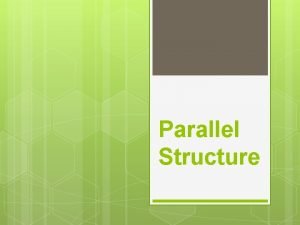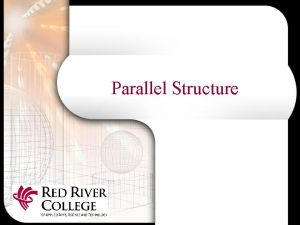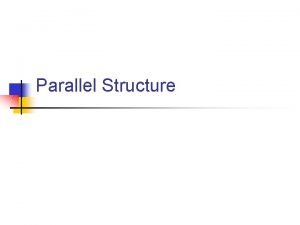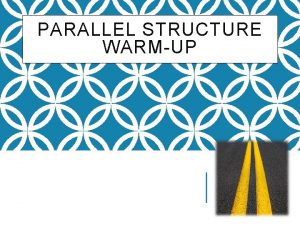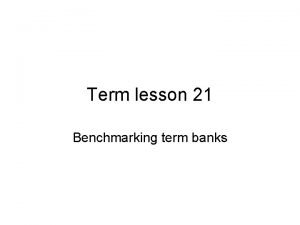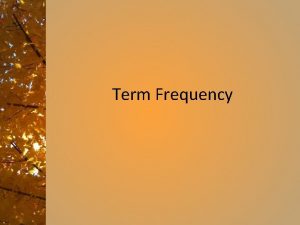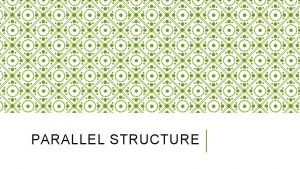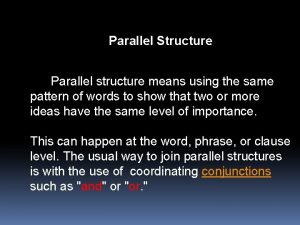Parallel structure Parallel structure The term parallel structure





![These are not parallel. Incorrect • Billy enjoys [reading books] and [then to watch These are not parallel. Incorrect • Billy enjoys [reading books] and [then to watch](https://slidetodoc.com/presentation_image_h2/41b7a731cb93fad1cdefb117ad5aaa9f/image-6.jpg)










- Slides: 16

Parallel structure

Parallel structure • The term “parallel structure” (often “parallelism”) means using the same pattern of words to show that two or more ideas have the same level of importance or serve the same grammatical function. • Parallel structure creates rhythm and balance in usage

Parallel structure • This can happen at the word, phrase, or clause level: • Word: • Billy and Sally went home after school. • Phrase: • Her room is either down this hall or around that corner. • Clause: • You can work on these problems either while you are in class or when you get home.

When to use parallel structure 1. Use parallel structure with elements joined by coordinating conjunctions 2. Use parallel structure with elements in lists or in a series 3. Use parallel structure with elements being compared 4. Use parallel structure with elements joined by a correlative conjunction

1. Use parallel structure with elements joined by coordinating conjunctions (FANBOYS) Incorrect • Billy enjoys reading books and then to watch the movies of those same books. Correct • Billy enjoys reading books and watching movies of those same books.
![These are not parallel Incorrect Billy enjoys reading books and then to watch These are not parallel. Incorrect • Billy enjoys [reading books] and [then to watch](https://slidetodoc.com/presentation_image_h2/41b7a731cb93fad1cdefb117ad5aaa9f/image-6.jpg)
These are not parallel. Incorrect • Billy enjoys [reading books] and [then to watch the movies of those same books]. Correct • Billy enjoys [reading books] and [watching movies of those same books].

2. Use parallel structure with elements in lists or in a series Incorrect Correct • On her camping trip Mary • On her camping trip wants to go hiking, Mary wants to go hiking, swimming, or to swimming, ride horses. or riding horses.

2. Use parallel structure with elements in lists or in a series – more complex Incorrect Correct • In assembling the basketball team, we looked for players whose looked for players [whose style of play was physical, style of play was physical], with impressive [whose backgrounds were backgrounds, and who had impressive], and [whose boundless potential was boundless].

3. Use parallel structure with elements being compared Incorrect Correct • It is better to lead by example than questioning the motives of those who try to lead. • It is better to lead by example than to question the motives of those who try to lead.

4. Use parallel structure with elements joined by a correlative conjunction Incorrect Correct • Sally not only wants money but also fame as well. • Sally wants not only money but also fame as well.

a( b + c + d ) • Think of parallel structure as the distributive property showing up in your English class. For lists, whether with two items or more, a (above) gets distributed evenly to all items on the list: ab, ac, ad. You need to cut the bread and peel the oranges. • a = “you need to”; b = “cut the bread”; c = “peel the oranges”

Caution with the distributive property! Make sure what gets distributed is appropriate for distribution to all items on the list. We found ants in the cabinets, the closets, and the table. a = “We found ants in” b = “the cabinets” c = “the closets” d = “the table” Ants in the table?

Caution with the distributive property! Make sure what gets distributed is appropriate for distribution to all items on the list. (not parallel) We found ants in the cabinets, the closets, and the table. (fixed) We found ants in the cabinets and closets and on the table. NOTICE there are two different distributions going on here. “We found ants” is distributed to “in the cabinets and closets” and “on the table”; “in the” is distributed to “cabinets” and “closets. ”

Some famous examples 1. It is better to give than to receive. 2. But in a larger sense – we cannot dedicate – we cannot consecrate – we cannot hallow this ground. 3. It was the best of times, it was the worst of times. 4. I came; I saw; I conquered. 5. I have nothing to offer but blood, toil, tears, and sweat.

Some sentences for you

1. Chuck is responsible for stocking the aisles, checking deliveries, and sales of merchandise. 2. Sally's style was remarkable for its dexterity, grace, and she could play any position. 3. The victims of this illness have sore throats, fevers and their heads hurt. 4. Before the barbecue, you should ignite some charcoal, have bought some steaks, and you should be preparing some marinade. 5. The sentence is difficult to understand not because the vocabulary is technical but because of faulty syntax.
 Short, medium and long term planning in education
Short, medium and long term planning in education In my understanding
In my understanding Long term memory vs short term memory
Long term memory vs short term memory Nth term of a sequence
Nth term of a sequence Short term human resources
Short term human resources Position-to-term rule
Position-to-term rule Difference between long term and short term liabilities
Difference between long term and short term liabilities Difference between long term and short term liabilities
Difference between long term and short term liabilities Minterm maxterm
Minterm maxterm Rules in finding the nth term
Rules in finding the nth term Term to term rule
Term to term rule Long term goal
Long term goal Long term and short term financial planning
Long term and short term financial planning Hát kết hợp bộ gõ cơ thể
Hát kết hợp bộ gõ cơ thể Lp html
Lp html Bổ thể
Bổ thể Tỉ lệ cơ thể trẻ em
Tỉ lệ cơ thể trẻ em





















